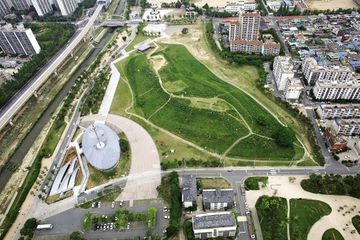김해 대성동 고분군(가야고분군)
| 김해 대성동 고분군 Ancient Tombs in Daeseong-dong, Gimhae |
|
 김해 대성동 고분군, 국가문화유산포털, 문화재청. |
|
| 대표명칭 | 김해 대성동 고분군 |
|---|---|
| 영문명칭 | Ancient Tombs in Daeseong-dong, Gimhae |
| 한자 | 金海 大成洞 古墳群 |
| 주소 | 경상남도 김해시 대성동 418-2번지 외 24필지 |
| 지정(등록) 종목 | 사적 제341호 |
| 지정(등록)일 | 1991년 1월 9일 |
| 분류 | 유적건조물/무덤/무덤/고분군 |
| 수량/면적 | 56,762㎡ |
| 웹사이트 | 김해 대성동 고분군, 국가문화유산포털, 문화재청. |
|
|
|
해설문
국문
대성동고분군은 1세기부터 5세기 전반까지 철 생산과 국제교역을 통해 전기 가야연맹을 주도했던 금관가야 왕과 지배층의 무덤들이다. 옛 김해만을 조망할 수 있는 김해분지 중심부의 독립된 낮은 구릉지에 분포한다.
1·2세기에는 구릉지의 낮은 쪽에 목관·목곽묘가 들어서다가 3세기부터 5세기 전반까지 대형 목곽묘가 구릉지의 정상부를 따라 조성된다. 대형 목곽묘는 구릉지의 북쪽에서 남쪽으로 순차적으로 축조되어 구릉지 전체에 밀집한다.
대형 목곽묘에는 유물부장을 위한 별도의 부곽을 만들고 금동관, 환두대도, 갑옷, 마구 등 위세품과 중국의 청동거울, 일본의 바람개비모양 동기 등 교역품을 부장하였다. 또한 이때부터 순장이 나타나기 시작하여 이후 가야 각국에 수용된다. 3세기 후반에 만들어진 29호분에서는 금동관이 출토되어 금관가야에 왕이 있었음을 보여준다.
대성동고분군은 우수한 철기문화를 바탕으로 중개무역을 통해 가야에서 가장 먼저 국가를 이룬 금관가야의 발전, 계층구조, 대외관계를 잘 드러내는 대표 고분군이다.
영문
Ancient Tombs in Daeseong-dong, Gimhae
These tombs are presumed to have been built between the 5th and 6th centuries for the kings and ruling class of Geumgwan Gaya, one of the members of the Gaya confederacy (42-562). Geumgwan Gaya was the first of the among the confederacy members to be established as a state, due to its abundant iron production and trade with neighboring states and kingdoms. It was located in the southeastern area of the Gaya confederacy, which is today’s Gimhae area, and played a dominant role in the confederacy until it was annexed by the Silla kingdom (57 BCE-935 CE) in 532.
Since the first archeological survey here in 1990, a number of excavations have been conducted, revealing that there are around 219 tombs scattered around this area. From the 1st to 2nd centuries, wooden coffin tombs and wooden chamber tombs were built on the lower part of the hill, and from the 3rd to early 5th centuries, larger wooden chamber tombs were built along the upper ridge of the hill. It was also found that Geumgwan Gaya was the first of the Gaya member states to bury human sacrifices with the deceased, and this practice spread from Geumgwan Gaya to the other member states.
The larger wooden chamber tombs consist of a main chamber for placing the body and an auxiliary chamber for containing burial goods, such as swords with 'a ring pommel, armor, horse harnesses, bronze mirrors from China, and pinwheel-shaped bronze tools from Japan. Notably, a gilt-bronze crown was discovered in Tomb No. 29, which dates to the 3rd century, showing that Geumgwan Gaya had a king.
영문 해설 내용
이 고분군은 가야연맹의 한 나라인 금관가야 지배자들의 무덤으로, 1세기부터 5세기 전반까지 조성된 것으로 추정된다. 금관가야는 철 생산과 국제교역을 통해 가야 연맹에서 가장 먼저 국가를 이루었다. 가야 남동부 지역(지금의 김해 지역)에서 전기 가야연맹을 주도했으며, 532년 신라에 복속되었다.
1990년 처음 조사가 이루어진 이후 현재까지 지속적인 조사 및 발굴을 통해 219기의 고분이 발견되었다. 1-2세기에는 구릉지의 낮은 쪽에 목관묘와 목곽묘가 들어서다가, 3세기부터 5세기 전반까지 대형 목곽묘가 정상부를 따라 조성되었다. 또한 금관가야에서 순장 풍습이 나타나기 시작하여, 이후 가야 각국에 수용되었다.
대형 목곽묘에는 시신을 묻기 위한 주곽 외에도 부장품을 묻기 위한 부곽을 만들고, 환두대도, 갑옷, 마구 등과 중국의 청동거울, 일본의 바람개비모양 동기 등을 묻었다. 3세기 후반에 만들어진 29호분에서는 금동관이 출토되어, 금관가야에 왕이 있었음을 보여준다.